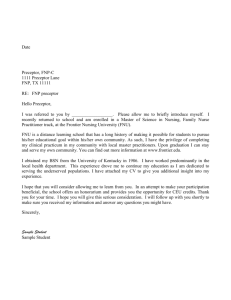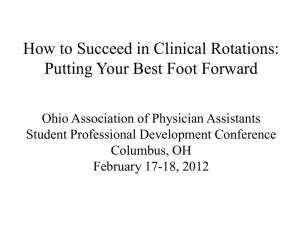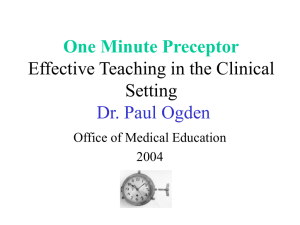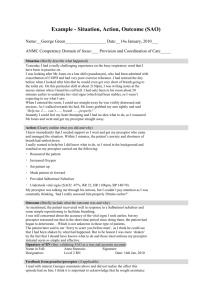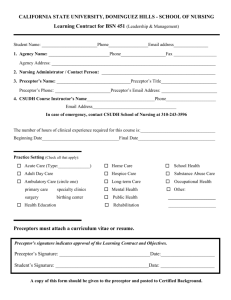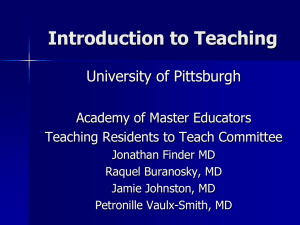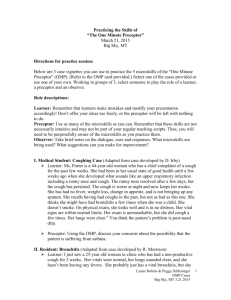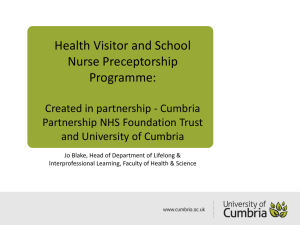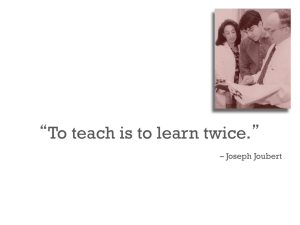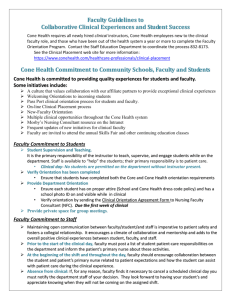The One Minute Preceptor - UBC Department of Family Practice
advertisement
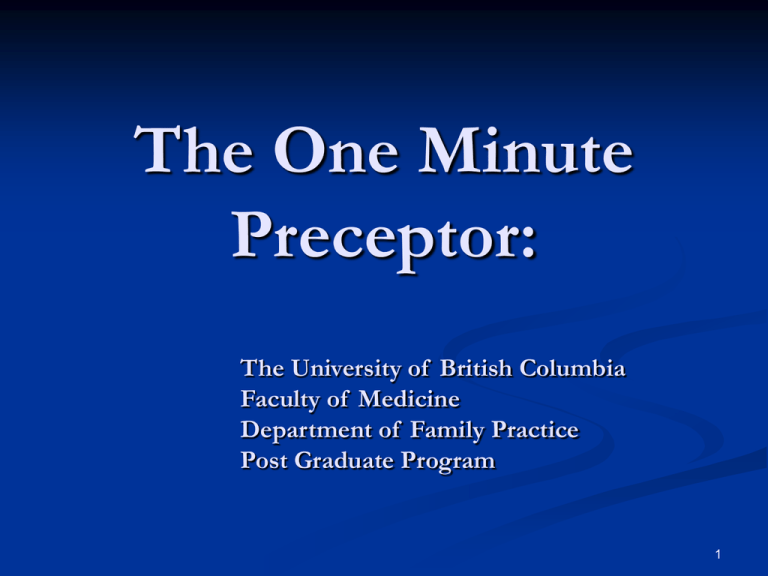
The One Minute Preceptor: The University of British Columbia Faculty of Medicine Department of Family Practice Post Graduate Program 1 5 Microskills for One-OnOne Teaching written by Dr. Garry Knoll Based on: Neher, J. O., Gordon, K. C., Meyer, B., & Stevens, N. (1992). A five-step "microskills" model of clinical teaching. Journal of the American Board of Family Practice, 5, 419424 2 What teaching techniques do you currently use? Take 2 minutes to write down the “techniques” you are consciously using to teach now. 3 One Minute Preceptor Objectives: List the Steps of the One-Minute Preceptor model of clinical teaching. Explain how each step fosters effective and efficient teaching. Demonstrate understanding of the One-Minute Preceptor on a sample student presentation. Integrate the One-Minute Preceptor model into your clinical teaching. 4 Typical Teaching Encounter 5 One Minute Preceptor The Five Steps 1/Get a Commitment 2/Probe for Supporting Evidence 3/Reinforce What Was Done Well 4/Give Guidance About Errors and Omissions 5/Teach a General Principle 6 One Minute Preceptor An Example 7 One Minute Preceptor What do you say next after being presented with this history? 8 One Minute Preceptor First Step Get a Commitment 9 First step: Getting a Commitment Suggested Questions: What do you thing is going on with this patient? What other diagnosis would you consider in this situation? What laboratory tests do you think we should get? How do you think we should treat this patient? 10 First step Getting a Commitment Notice that questions used in getting a commitment do not simply gather further data about the case. The goal is to gain insight into the learner's reasoning. 11 One Minute Preceptor Second Step Probe for Supporting Evidence Give some examples of questions which probe for the rationale for an answer. What is the learner thinking? 12 Second Step: Probe for Supporting Evidence Suggested Questions: What factors in the history and physical support your diagnosis? What do not? Why would you choose that particular medication? Why do you feel this patient should be hospitalized? Why do you feel it is important to do that part of the physical in this situation? 13 Second Step: Probe for Supporting Evidence This step allows the preceptor to closely observe the vital skill of clinical reasoning and to assist the learner in improving and perfecting that skill. 14 One Minute Preceptor Third Step Reinforce What Was Done Well Give some examples of statements you might use to reinforce what was well done 15 Third Step: Reinforce what was done well Possible reinforcement: “Your diagnosis of `probable pneumonia' was well supported by your history and physical. You clearly integrated the patient's history and your physical findings in making that assessment.” “Your presentation was well organized. You had the chief complaint followed by a detailed history of present illness. You included appropriate additional medical history and medications and finished with a focused physical exam.” 16 Third Step: Reinforce what was done well With a few sentences you have reinforced positive behaviors and skills and increased the likelihood that they will be incorporated into further clinical encounters. 17 One Minute Preceptor Fourth Step Give Guidance About Errors and Omissions Can you give some examples ? 18 Fourth step: Give Guidance about errors and omissions Examples: “In your presentation you mentioned a temperature in your history but did not tell me the vitals signs when you began your physical exam. Following standard patterns in your presentations and note will help avoid omissions and will improve your communication of medical information.” “I agree that, at some point, complete pulmonary function testing may be helpful, but right now the patient is acutely ill and the results may not reflect her baseline and may be very difficult for her. We could glean some important information with just a peak flow and a pulse oximeter.” 19 Fourth step: Give Guidance about errors and omissions In a few sentences an opportunity for behavior change has been identified and an alternative strategy given. 20 One Minute Preceptor Fifth Step Teach a General Principle Suggest a general principle that could be taught in this scenario. 21 Fifth step: Teach a general principle Examples: “Smokers are more likely than non-smokers to be infected with gram-negative organisms. This is one situation where you may need to broaden your antibiotic coverage to be sure to cover these more resistant organisms.” “Deciding whether someone needs to be treated in the hospital for pneumonia is challenging. Fortunately there are some criteria that have been tested which help...” “In looking for information on what antibiotics to choose for a disease I have found it more useful to use an up-to-date hand book than a textbook which may be several years out of date.” 22 Fifth step: Teach a general principle A statement or two outlining a relevant and practical teaching point can have a significant impact on the learner. 23 One Minute Preceptor Conclusion 24 Conclusion Example: “OK, now we'll go back in the room and I'll repeat the lung exam and talk to the patient. After, I'd like you to help the nurse get a peak flow, a pulse ox, and a CBC. When we have all those results, let me know and we can make a final decision about the need for hospitalization and our treatment plan.” 25 Conclusion The teaching encounter is smoothly concluded and the roles and expectations for each person are made clear in a way that will facilitate further learning and optimize patient care. 26 Summary The more the student processes and the less you say ….the more successful the encounter is likely to be. 27 Thank You This module was written as an aid to the Preceptors in the Postgraduate Family Practice Program at the University of BC. Study credit is available to groups of preceptors who complete the module Please give us your feedback on the module so that we may improve it for others. Email your comments to Dr. Fraser Norrie, Faculty Development, UBC Family Practice fraser.norrie@vch.ca 28
